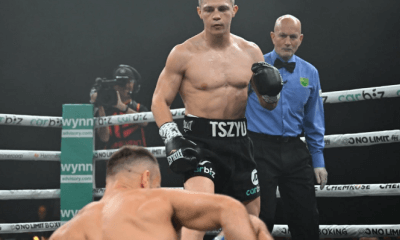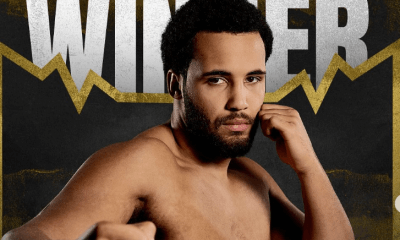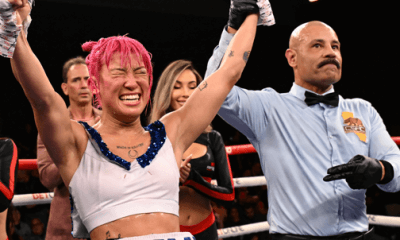Featured Articles
The Patterson vs Johansson Fight That Could Never Happen Now as it Did Then

Dr. Margaret Goodman, the Las Vegas-based neurologist and former chief ringside physician for the Nevada State Athletic Commission, has never seen the tape of the first of three Floyd Patterson-Ingemar Johansson fights, which took place on June 26, 1959, in Yankee Stadium. But she has heard the details of the remarkable third round of that heavyweight championship bout and, as a tireless crusader for increased safety in boxing, she never does want to see it.
The mere idea of Patterson, the about-to-be-dethroned champ, being floored seven times in a single round, and clearly discombobulated after the first of those floorings, is enough to make the good doctor, recipient of the 2016 Boxing Writers Association of America’s Barney Nagler Award for long and meritorious service to the sport, cringe.
“Seven knockdowns in one round are obviously excessive,” she said. “Thank goodness times have changed, but I still see some fights now that I think should have been stopped a lot earlier. (Anthony) Joshua was knocked down four times against (Andy) Ruiz and he was quoted as saying he didn’t remember what happened after the second knockdown, or maybe it was the third.
“The standard for the way things were handled back then (1959) were different. There was a greater likelihood of allowing a fighter to continue taking that kind of punishment. How horrible is that?
“Is boxing safer today? I think maybe it is in some ways. Maybe we’re just more aware of what’s going on. I do wish fighters were evaluated more closely. And it’s not just the number of knockdowns that matter; one knockdown can be just as much of a concern in some instances. And so much depends on other factors. What is a fighter’s prefight history? Was he taking multiple shots in the gym that went unrecognized that might have contributed to his being knocked down more readily in an actual fight? Then there’s hereditary factors, genetic factors. There are a lot of questions that aren’t always answered. I’d much rather see a fighter quickly knocked out than to suffer blow after blow after blow to the head.”
This story was to have been a simple look back at a classic fight that is fast approaching its 60-year anniversary. Johansson – Sweden’s once-disgraced heavyweight silver medalist at the 1952 Helsinki Olympics – would ride the momentum of those seven knockdowns, squeezed into just 123 elapsed seconds of round three, into one of the most bountiful hauls of honors any fighter has ever received for a single performance. The handsome, charming 26-year-old, dubbed “boxing’s Cary Grant” by one publication, would be awarded the Hickok Belt as the top professional athlete of 1959 as well as being named Associated Press Athlete of the Year and Sports Illustrated Sportsman of the Year. His smiling face appeared on the covers of SI and Life magazines, the latter also adorned by Ingo’s smokin’ hot Swedish girlfriend, Birgit Lundgren. Johansson also snagged a role in a Hollywood movie, 1960’s All the Young Men, in which he played a U.S. Marine during the Korean War, albeit one with a distinctly Scandinavian accent, in support of leads Alan Ladd and Sidney Poitier.
There would be no such high-profile victory tour for the vanquished Patterson, but he would get the better of Johansson in two subsequent bouts, each by knockout. And although both men would go on to be inducted into the International Boxing Hall of Fame, Patterson in 1991 and Johansson in 2002, the consensus among historians of the sport is that neither was as accomplished enough a heavyweight to be considered among the division’s all-time best. Patterson, a quiet and dignified gentleman outside the ring, and Ingo, the international bon vivant, were probably fortunate to have found each other during a comparatively fallow period for big-man boxing.
But one person’s snack is another’s feast, and especially so if the feaster is an 11-year-old boy whose dad, a former pro welterweight, was treating his only son to his first fight telecast at a closed-circuit venue, then the cutting edge of late 1950s technology. Instead of watching Patterson-Johansson at home on a small black-and-white television with a blurry screen, I got to see it in New Orleans’ magnificent Saenger Theater, in black-and-white on a much larger, blurry screen. When it was over and Ingo anointed as the new king of the heavyweights, the love affair I already had with boxing, which began years earlier with Friday night telecasts of the Gillette Cavalcade of Sports, had deepened into what would become a life-long obsession.
The way a child looks at something, however, often differs from the way an adult does, and maybe even more so when your grown-up self is a veteran sports reporter who is paid to look beyond the surface to discern some greater truth, if there is one. The adrenaline rush I got at 11 from seeing seven quick knockdowns has since been tempered by asking myself the type of questions Dr. Goodman wishes would be asked and answered before any fighter steps inside the ropes.
Was Ruby Goldstein, then 51 and a former fighter who was one of high-level boxing’s most distinguished referees, remiss for allowing a dazed and stumbling Patterson to keep being battered as if he were a human piñata? By today’s more stringent safety standards, absolutely. Johansson was a fighter of relatively limited skills, but he was possessed of an overhand right so powerful that it bore three nicknames – the “Hammer of Thor,” “Ingo’s Bingo” and, when spoken in English coated by Johansson’s Swedish accent, “Toonder and Lightning,” the toonder a reference to thunder. When the challenger came straight down the pike with that three-headed monster of a right and it landed flush to the jaw, Patterson went down as he were a ship at port’s dropped anchor.
Floyd beat the count, but he was so hurt and flummoxed that he thought the round was over. He turned to scuffle back to his corner, presenting the opportunity for Johansson to run up alongside him and score knockdown No 2 with an uncontested left hook to the side of the head, followed up by a right to the back of the head. After that the fight resembled a basketball game, with Ingo making like Boston Celtics guard Bob Cousy and bouncing Patterson up and down off the canvas. This went on until even Goldstein had seen enough and waved off the massacre after an elapsed time of 2 minutes, 3 seconds.
It should be noted that Goldstein, a 1994 inductee into the IBHOF, was the referee for the March 24, 1962, death match in which Benny “Kid” Paret, hung up on the ropes in the 12th round, was pummeled into unconsciousness by Emile Griffith’s blistering, two-handed attack. He remained in a coma until his death 10 days later. Goldstein, remorseful that he was slow to react to Paret’s fast-worsening circumstances, never again served as the third man in the ring. I wonder if, in retrospect, he had misgivings about allowing the third round of Patterson-Johansson I to continue past a point when it was obvious to everyone, even an 11-year-old boy in a movie theater in New Orleans, that the champion had nothing left to give, much less any hope of mounting a miraculous comeback.
You also wonder whether Patterson and Johansson, if they could have peered into the future and seen how their lives would eventually play out, would still have chosen to make their mark in a blood sport that demands so much, and sometimes all, of its participants. Probably they would have; asked the same question, Muhammad Ali, his voice all but stilled by Parkinson’s Syndrome, said he wouldn’t have changed anything about a life lived larger than most people could ever imagine. Told once that he held the dubious record of being knocked down 17 times in heavyweight title bouts, nine of those coming against Johansson, Patterson said, “That’s true, but I also hold the record for getting up the most times.”
Floyd Patterson was 71 when he passed away on May 11, 2006, in New Paltz, N.Y. A two-term head of the New York State Athletic Commission, he resigned that post years earlier when subordinates began to notice that their boss could no longer remember the name of his secretary, or even that of his wife. Alzheimer’s disease had had the chilling effect of erasing most of his memories even before prostate cancer served to hasten the 10-count he never received from the recalcitrant Goldstein that fateful summer night in 1959.
Johansson’s death, at 76 on Jan. 30, 2009, in a nursing home in Kungsbacka, Sweden, mirrored that of his onetime arch-rival. Like Patterson, he spent his earthly championship rounds in a sort of netherworld, slipping ever deeper into the dark cave of Alzheimer’s and dementia. Ingo was too ill to attend his IBHOF induction, and he was two years gone when his hometown of Gothenburg unveiled a statue of him in 2011, outside the Ullevi stadium where, on Sept. 14, 1958, he had earned the shot at Patterson’s title by scoring a first-round knockout of highly ranked American contender Eddie Machen, before 53,615 screaming Swedes.
It is a testament to the unifying bonds of boxing that two men who had taken each other to hell and back could later become fast friends, forever to be linked in death as they for so long were linked in life. That is not always the case, of course, but then almost from the beginning Floyd and Ingo seemed to recognize that they were more alike than different, two sides of the same coin, too similar in many ways to be separated by skin color, lifestyle or an ocean.
Check out more boxing news on video at The Boxing Channel
To comment on this story in The Fight Forum CLICK HERE
-

 Featured Articles4 weeks ago
Featured Articles4 weeks agoThe Hauser Report: Zayas-Garcia, Pacquiao, Usyk, and the NYSAC
-

 Featured Articles3 weeks ago
Featured Articles3 weeks agoOscar Duarte and Regis Prograis Prevail on an Action-Packed Fight Card in Chicago
-

 Featured Articles2 weeks ago
Featured Articles2 weeks agoThe Hauser Report: Cinematic and Literary Notes
-

 Book Review2 weeks ago
Book Review2 weeks agoMark Kriegel’s New Book About Mike Tyson is a Must-Read
-

 Featured Articles4 weeks ago
Featured Articles4 weeks agoRemembering Dwight Muhammad Qawi (1953-2025) and his Triumphant Return to Prison
-

 Featured Articles7 days ago
Featured Articles7 days agoMoses Itauma Continues his Rapid Rise; Steamrolls Dillian Whyte in Riyadh
-

 Featured Articles3 weeks ago
Featured Articles3 weeks agoRahaman Ali (1943-2025)
-

 Featured Articles3 weeks ago
Featured Articles3 weeks agoTop Rank Boxing is in Limbo, but that Hasn’t Benched Robert Garcia’s Up-and-Comers


















